-
收藏模板
- 模板信息
- 更新时间:2023-09-24
- 字数:约13235字
- 页数:约7页
- 格式:.docx
- 推荐版本:Office2016及以上版本
- 售价:5 金币
您可能喜欢的文档
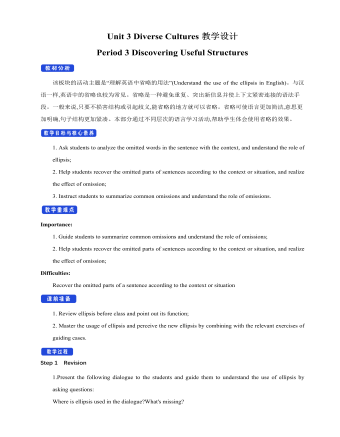
新人教版高中英语必修3Unit 3 Diverse Cultures教学设计三
The price is the same as(the price was)before the war.价格与战前相同。(4)定语从句中的“关系代词+助动词be”可以省略。The ticket(that/which was)booked by his sister has been sent to him.他妹妹订的那张票已送到了他那里。Step 5 PracticeActivity 3(1) Guide students to complete the four activities in the Using Structures part of exercise book, in which activities 1 and 2 focus on ellipsis in dialogue answers, activity 3 focus on signs and headlines, two typical situations where ellipsis is used, and activity 4 focus on ellipsis in diary, an informal style.(2) Combine the examples in the above activities, ask students to summarize the omitted situations in groups, and make their own summary into a poster, and post it on the class wall after class to share with the class.(This step should give full play to the subjectivity of students, and teachers should encourage students to conclude different ellipsis phenomena according to their own understanding, they can conclude according to the different parts omitted in the sentence.)Step 6 Homework1. Understand and master the usages of ellipsis;2. Finish the other exercises in Using structures of Workbook.1、通过本节内容学习,学生是否理解和掌握省略的用法;2、通过本节内容学习,学生能否根据上下文语境或情景恢复句子中省略的成分,体会使用省略的效果;3、通过本节内容学习,学生能否独立完成练习册和导学案中的相关练习。
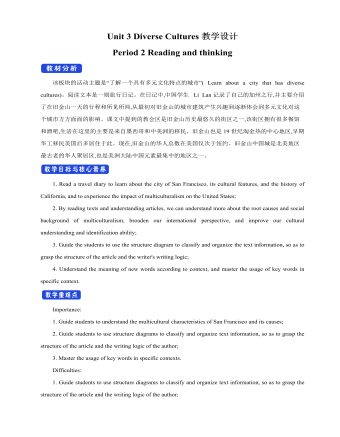
新人教版高中英语必修3Unit 3 Diverse Cultures教学设计二
(2)Consolidate key vocabulary.Ask the students to complete the exercises of activity 6 by themselves. Then ask them to check the answers with their partners.(The first language:Damage of the 1906 San Francisco earthquake and fire.A second language: Yunnan - one of the most diverse provinces in China).Step 5 Language points1. The teacher asks the students to read the text carefully, find out the more words and long and difficult sentences in the text and draw lines, understand the use of vocabulary, and analyze the structure of long and difficult sentences.2. The teacher explains and summarizes the usage of core vocabulary and asks the students to take notes.3. The teacher analyzes and explains the long and difficult sentences that the students don't understand, so that the students can understand them better.Step 6 Homework1. Read the text again, in-depth understanding of the text;2. Master the use of core vocabulary and understand the long and difficult sentences.3. Complete relevant exercises in the guide plan.1、通过本节内容学习,学生是否理解和掌握阅读文本中的新词汇的意义与用法;2、通过本节内容学习,学生能否结合文本特点了解文章的结构和作者的写作逻辑;3、通过本节内容学习,学生能否了解旧金山的城市风貌、文化特色,以及加利福尼亚州的历史,体会多元文化对美国的影响。

新人教版高中英语必修3Unit 3 Diverse Cultures教学设计四
该板块的活动主题是“介绍一个有显著文化特征的地方”( Describe a place with distinctive cultural identity)。该板块通过介绍中国城继续聚焦中国文化。本单元主题图呈现的是旧金山中国城的典型景象, Reading and Thinking部分也提到中国城,为该板块作铺垫。介绍中国城的目的主要是体现中国文化与美国多元文化的关系,它是美国多元文化的重要组成部分。中国城也是海外华人的精神家园和传播中国文化的重要窗口,外国人在中国城能近距离体验中国文化。1. Read the text to understand the cultural characteristics of Chinatown in San Francisco and the relationship between Chinese culture and American multiculturalism;2. Through reading, learn to comb the main information of the article, understand the author's writing purpose and writing characteristics;3. Learn to give a comprehensive, accurate, and organized description of the city or town you live in;Learn to revise and evaluate your writing.Importance:1. Guide the students to read the introduction of Chinatown in San Francisco and grasp its writing characteristics;2. Guide students to introduce their city or town in a comprehensive, accurate and organized way;3. Learn to comb the main information of the article, understand the author's writing purpose, and master the core vocabulary.
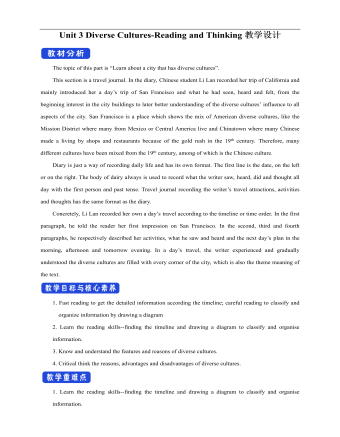
新人教版高中英语必修3Unit 3 Diverse Cultures-Reading and Thinking教学设计
Discuss these questions in groups.Q1: Have you ever been to a place that has a diverse culture ? What do you think about the culture diversity ?One culturally diverse place that I have been to is Harbin, the capital city of Heilongjiang Province. I went there last year with my family to see the Ice and Snow Festival, and I was amazed at how the culture as different to most other Chinese cities. There is a big Russian influence there, with beautiful Russian architecture and lots of interesting restaurants. I learnt that Harbin is called “the Oriental Moscow” and that many Russians settled there to help build the railway over 100 years ago.Q2: What are the benefits and challenges of cultural diversity ?The benefits: People are able to experience a wide variety of cultures, making their lives more interesting, and it can deepen the feelings for our national culture, it is also helpful for us to learn about other outstanding culture, which helps improve the ability to respect others. The challenges: People may have trouble communicating or understanding each other, and it may lead to disappearance of some civilizations and even make some people think “The western moon is rounder than his own.”Step 7 Post reading---RetellComplete the passage according to the text.Today, I arrived back in San Francisco, and it feels good (1) _____(be) back in the city again. The city succeeded in (2)_________ (rebuild) itself after the earthquake that (3)________ (occur) in 1906, and I stayed in the Mission District, enjoying some delicious noodles mixed with cultures. In the afternoon, I headed to a local museum (4)____ showed the historical changes in California. During the gold rush, many Chinese arrived, and some opened up shops and restaurants in Chinatown to earn a (5)_____ (live). Many others worked on (6)______ (farm), joined the gold rush, or went to build the railway that connected California to the east. The museum showed us (7)____ America was built by immigrants from (8)________ (difference) countries and cultures. In the evening, I went to Chinatown, and ate in a Cantonese restaurant that served food on (9)________(beauty) china plates. Tomorrow evening, I’m going to (10)__ jazz bar in the Richmond District. 答案:1. to be 2. rebuilding 3. occurred 4. that 5.living6. farms 7.how 8. different 9. beautiful 10. a
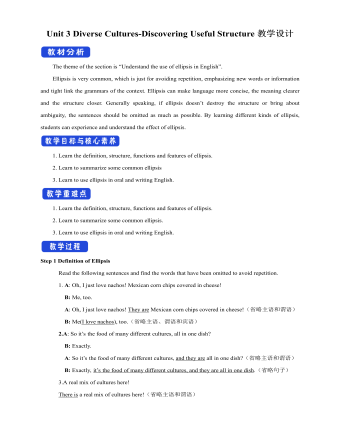
新人教版高中英语必修3Unit 3 Diverse Cultures-Discovering Useful Structure教学设计
Step 4 PracticeRead the conversation. Find out which words have been left out.Justin: Linlin, I’m going to Guizhou Province next month. I’m super excited! Any recommendations for places to visit?Linlin: Wow, cool! Guizhou is a province with a lot of cultural diversity. Places to visit...well, definitely the Huangguoshu Waterfall first.Justin: What’s special about the waterfall?Linlin: Well, have you ever heard of the Chinese novel Journey to the West ?Justin: Yes, I have. Why ?Linlin: In the back of the waterfall, you will find a cave, which is the home of the Monkey King.Justin: Really? Cool! I’ll definitely check it out.Linlin:And I strongly recommend the ethnic minority villages. You’ll find Chinese culture is much more diverse than you thought.Justin:Sounds great, thanks.Answers:Justin: Linlin, I’m going to Guizhou Province next month. I’m super excited! Do you have any recommendations for places to visit?Linlin: Wow, that’s cool! Guizhou is a province with a lot of cultural diversity. What are some places to visit in Guizhou ? Well, definitely the Huangguoshu Waterfall is the first place to visit in Guizhou Province.Justin: What’s special about the waterfall?Linlin: Well, have you ever heard of the Chinese novel Journey to the West ?Justin: Yes, I have heard of the Chinese novel Journey to the West . Why do you ask if I have heard of the Chinese novel Journey to the West?Linlin: In the back of the waterfall, you will find a cave, which is the home of the Monkey King from Journey to the West.Justin: That’s really true? It’s Cool! I’ll definitely check it out.Linlin:And I strongly recommend the ethnic minority villages on your trip to Guizhou Province. You’ll find Chinese culture is much more diverse than you thought it was.Justin:This all sounds great, thanks.
- 查看更多相关Word文档
Unit 3 DiverseCultures教学设计
Period 1 Listening andspeaking
听力部分分为两个部分:Listening andspeaking和Listening and talking。
Listening and speaking板块的活动主题是“讨论几种美国食品的起源”( Talk about the origins ofAmerican food)。美国的多元文化反映在社会生活的各个领域,饮食就是很重要的一个方面。该板块介绍了四种食品——汉堡包、墨西哥玉米片、秋葵汤和福饼,它们都是在美国本土发明的,但都带有其他民族的饮食风味和特点。在文化交流过程中,不同民族的文化接触后会产生碰撞,同时也会根据需要从不同的文化体系中选取文化元素,经过整合融为一体,形成一种新的文化体系,这就是文化融合的过程。

现代美国文化就是多种文化融合的结果,而这里介绍的几种美国食品正是文化融合现象的具体表现。听力对话的最后一句道出了美国饮食的特点:将世界上的不同食材混合在一起,创造出一种全新的食品。
Listening and talking板块的活动主题是“谈论中国的少数民族文化”( Talk aboutethnic minority cultures in China)。此部分从谈论美国的多元文化过渡到谈论中国文化的多样性。少数民族文化是中国文化多样性的重要体现。该板块围绕贵州苗族和侗族的少数民族文化展开。民族文化是民族身份的重要标志,了解中国文化的多样性有助于培养文化自信,弘扬和传承中国文化。了解中国异彩纷呈的少数民族文化也有助于学生形成尊重、包容的心态,为维护和谐社会作出贡献。
1. Master themethods and skills of note-taking, understand the logic of listening materials(including the expression of transition, contrast, cause and effect,coincidence, and examples), so as to determine the key information;
2. Help studentsunderstand the manifestation of American multiculturalism in diet by listeningto an interview, and guide students to record key information in the listeningprocess;
3. Instructstudents to clearly introduce the characteristics and cooking methods of aChinese national food to their partners;
4. Master theprinciple of dividing long sentences into groups, and be able to use pauseskills when reading long sentences or oral expressions.
5. Be able tointroduce Chinese minority culture and tell Chinese stories in English.
Importance:
1. Help studentsunderstand the manifestation of American multiculturalism in diet by listeningto an interview, and guide students to record key information in the listeningprocess;
2. Instruct thestudents to clearly introduce the characteristics and cooking methods of aChinese national food to their partners.
3. Be able tointroduce Chinese minority culture and tell Chinese stories in English.
Difficulties:
1. Clearlyintroduce the characteristics and cooking methods of a Chinese national food tothe partners;
2. Master theprinciple of dividing long sentences into groups, and be able to use pauseskills reasonably when reading long sentences or oral expressions.
3. Be able tointroduce Chinese minority culture and tell Chinese stories in English.
1. Review thevocabulary about food and understand the characteristics of Chinese traditionalfood culture;
2. Read thissection in advance, review the vocabulary of American food, and understand thecharacteristics of American food culture.
Step 1 Lead-in
1.The teacherpresents a news report to help students understand the meaning of diverse inthe title.
Overseas Students Experience Diverse Cultures at Shandong University
Shandong University in Jinan, East ChinasShandong Province unveiled its I8th International Cultural Festival at itscentral campus on April 26, offering locals a chance to experience uniquecultures from 25 countries around the world.
Overseas students from Russia, France,Thailand, Afghanistan, Italy, Uganda, and Laos wore traditional costumes asthey showcased food,dances,handcrafts,and souvenirs from their home countries.
Since 2001, the international culturalevent has evolved into an important channel the university to promote itscampus culture featuring understanding, inclusiveness.for openness, andprogress.
2.According to theabove context, the teacher guides the students to discuss the meaning ofdiverse cultures, and then asks them to try to explain the meaning of unittitle "diverse cultures" in their own language.Students can explainit this way :
It means the coexistence of many differenttypes of cultures in a specific region or in the world as a whole. Each culturehas its distinct features and each other’s differences are respected.
Step 2 Watching and talking
Activity 1
1.Teachers makesfull use of pictures to find the breakthrough of unit teaching.The followingquestions can guide students to observe the details in the picture, so as tounderstand the cultural information and its connotation carried by the picture,and establish a connection with the unit theme.
What can you seein the photo?(buildings, lamp post, lanterns.) Do you find the place familiar?
What are somewords on the buildings?
Why are there bothChinese and English shop signs?
Where do you thinkthis photo was taken?
What day you thinksuch a place is like?
Do you think thisis a typical place to show cultural diversity? Why?
2.Appreciatefamous quotes.The teacher asks the following questions to help studentsunderstand the quotation and relate the unit topic:
Can you paraphrasethe quote in your own words?
Can you give someexamples to demonstrate the diversity of people in world?
Can you think ofsome examples to show diverse cultures in the world?
3.Ask the studentsto quickly review the listening, speaking, reading and writing tasks listed inthe opening page. Then ask the students to close their books and answer thepositive questions.
What are some topicsyou will read about/ listen to?
What are sometopics you will talk/write about?
Which part do youthink will interest you?
What do you expectto learn from this unit?
Step 3 Listening
Activity 2
1.Ask the studentsto look at the four pictures in activity 1.
2.Students wereasked to match the picture to the following description and then to try tomatch it to the name of the food.
Picture A: smallpieces of thin crisp chips served with beans, cheese, spices, etc (nachos).
Picture B: a crisphollow cookie containing a piece of paper with a short message on it (fortunecookie).
Picture C: a thickseafood soup,a spicy stew(gumbo).
Picture D: asandwich containing cooked meat and some other vegetables in a bread roll(hamburger).
Activity 3
1.The teacherplays the recording for the first time and asks the students to verify whetherthe matching food names in activity 1 are correct.
2. The teacherplays the recording for the second time. The teacher arranges the followingquestions in advance to guide the students to get the key information and graspthe general meaning of the listening dialogue.
Where does thisconversation take place? How do you know?
Who are thespeakers?
What is the topicof the conversation?
What is SteveFox’s opinion about American food?
How many examplesdoes Steve Fox give to support his opinion? What are they?
Activity 4
1.Look at the fivesentences in activity 3.Lets listen to the tape for the third time.The teacherfirst lets the student understand the problem, then completes the listeningtask, in this way the student listens with the purpose, is helpful to developthe selective attention strategy.
2.Ask the studentsto browse the listening task of activity 4. First, try to fill in theinformation in the form from memory.Next, the teacher plays the tape again andasks the students to fill out the rest of the information and reminds them touse the shorthand strategy.If students can fill out most of the information,teachers can ask them to fill in more information on the form as theylisten.When the students were finished, they were asked to use the informationin the table to organize the language and verbally describe each food.
3.Listen to thetape again and ask the students to complete the following sentences in the listeningtext.
He’s here to talkabout cultural influences on American food.
You mean there wasa mixing of cultures? Food from overseas changed when it arrived in theStates.
And there are manymore examples of mixed-culture dishes.
So they’re like amix of the Chinese, American, and Japanese cultures.
It was invented inNew Orleans over 200 years ago, and mixes French, African, NativeAmerican, and Spanish cooking.
So its the foodof many different cultures, all in one dish?
American cookingoften mixes things from around the world to make something completelynew.
Step 4 Speaking
Activity 5
1.Teachers can usecourseware to show pictures and definitions of potluck to introduce thisinteresting cultural phenomenon to students.Such as:
A potluck dinner is a meal to which eachguest brings a dish of food prepared by the person, to be shared among thegroup.
2.Next, theteacher can ask the following questions to start thinking:
How do you thinkpotluck dinners show diverse cultures in the world?
What food wouldyou bring to the party if you were invited?
Why do you choosethis food?
3.Teachers createa situation and ask students to create a dialogue in pairs. One student ACTS asa guest invited to a potluck party and the other gives advice as a friend.Eachgroup is asked to have a conversation about the origin, preparation andcharacteristics of a food according to the three questions in activity5.Students can also add cultural information about the history and legends ofthe food.After the students have finished the drill, the teacher may askseveral groups of students to present to the class.
Step 5 Pronunciation
Activity 6
1. Understand thespoken text.Read the passage silently and answer the following questions:
What is this textabout?
What did you learnabout them from the text?
2.Mark the pausesin the passage. Then ask one of the students to read to the class.Incombination with the students problems in pausing, help students understandthe role of pausing: first, pausing allows us to take a breath in time, so thatwe wont be so tired in the process of speaking;Secondly, proper pauses allowus to better grasp the rhythm of speaking and express ourselves.
3. The teacherplays the recording, guides the students to make necessary modifications, andsummarizes the common positions of pauses.
4. Listen to thetape again and ask the students to follow the tape.
5. Let thestudents read the passage in pairs. Help each other to improve the accuracy andfluency of reading.Finally, please have a few students present to the class.
Step 6 Listening
Activity 7
1.Ask students tofocus on the three pictures in activity 1 and try to describe each picture,including:
Photo 1: Where do you think these men are from?What are they doing? What are they holding in their hands? What is theinstrument like? What arc their clothes like?
Photo 2: Where do you think the girls are from?What are they doing? What are their clothes like?What are they wearing on theirheads?
Photo 3: Can you find in the photo which villageit is? What time is it in the photo? What is the village like?
Based on thedescription of the students, the teacher skillfully penetrated the key words inthe listening dialogue, such as silver, accessory, minority, musicalinstrument, perform, etc.
2.Its about theethnic minority cultures of the Miao and Dong people in China. Its about theethnic minority cultures of the Miao and Dong people in China.
3.Let the studentsfocus on the Miao and Dong ethnic groups, share their understanding of the twoethnic minorities, fully activate the students background knowledge, andprepare for the following listening activities.
转载请注明出处!本文地址:
https://www.lfppt.com/worddetails_28325054.html最新课件教案文档
-

精选高中生期末评语
1、该生学习态度端正 ,能够积极配合老师 ,善于调动课堂气氛。 能够积极完成老师布置的任务。学习劲头足,听课又专注 ,做事更认 真 ,你是同学们学习的榜样。但是,成绩只代表昨天,并不能说明你 明天就一定也很优秀。所以,每个人都应该把成绩当作自己腾飞的起 点。2、 你不爱说话 ,但勤奋好学,诚实可爱;你做事踏实、认真、为 人忠厚 ,是一个品行端正、有上进心、有良好的道德修养的好学生。在学习上,积极、主动,能按时完成老师布置的作业,经过努力 ,各 科成绩都有明显进步,你有较强的思维能力和学习领悟力,学习也有 计划性,但在老师看来,你的潜力还没有完全发挥出来,学习上还要有持久的恒心和顽强的毅力。
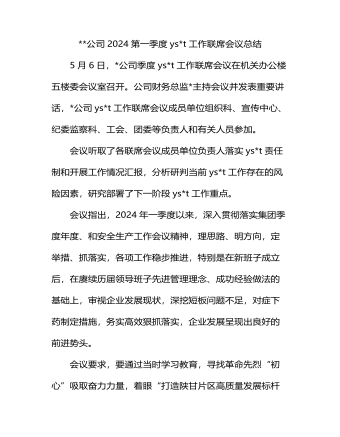
公司2024第一季度意识形态工作联席会议总结
一是要把好正确导向。严格落实主体责任,逐条逐项细化任务,层层传导压力。要抓实思想引领,把理论学习贯穿始终,全身心投入主题教育当中;把理论学习、调查研究、推动发展、检视整改等有机融合、一体推进;坚持学思用贯通、知信行统一,努力在以学铸魂、以学增智、以学正风、以学促干方面取得实实在在的成效。更加深刻领会到******主义思想的科学体系、核心要义、实践要求,进一步坚定了理想信念,锤炼了政治品格,增强了工作本领,要自觉运用的创新理论研究新情况、解决新问题,为西北矿业高质量发展作出贡献。二是要加强应急处事能力。认真组织开展好各类理论宣讲和文化活动,发挥好基层ys*t阵地作用,加强分析预警和应对处置能力,提高发现力、研判力、处置力,起到稳定和引导作用。要坚决唱响主旋律,为“打造陕甘片区高质量发展标杆矿井”、建设“七个一流”能源集团和“精优智特”新淄矿营造良好的舆论氛围。三是加强舆情的搜集及应对。加强职工群众热点问题的舆论引导,做好舆情的收集、分析和研判,把握时、度、效,重视网上和网下舆情应对。
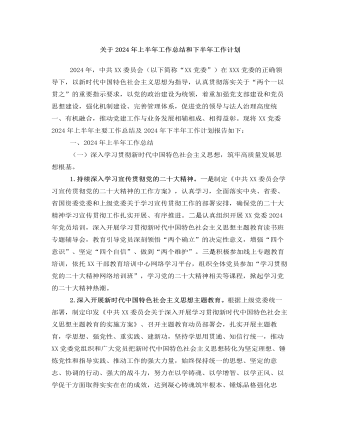
关于2024年上半年工作总结和下半年工作计划
二是深耕意识形态。加强意识形态、网络舆论阵地建设和管理,把握重大时间节点,科学分析研判意识形态领域情况,旗帜鲜明反对和抵制各种错误观点,有效防范处置风险隐患。积极响应和高效落实上级党委的决策部署,确保执行不偏向、不变通、不走样。(二)全面深化党的组织建设,锻造坚强有力的基层党组织。一是提高基层党组织建设力量。压实党建责任,从政治高度检视分析党建工作短板弱项,有针对性提出改进工作的思路和办法。持续优化党建考核评价体系。二是纵深推进基层党建,打造坚强战斗堡垒。创新实施党建工作模式,继续打造党建品牌,抓实“五强五化”党组织创建,广泛开展党员教育学习活动,以实际行动推动党建工作和经营发展目标同向、部署同步、工作同力。三是加强高素质专业化党员队伍管理。配齐配强支部党务工作者,把党务工作岗位作为培养锻炼干部的重要平台。
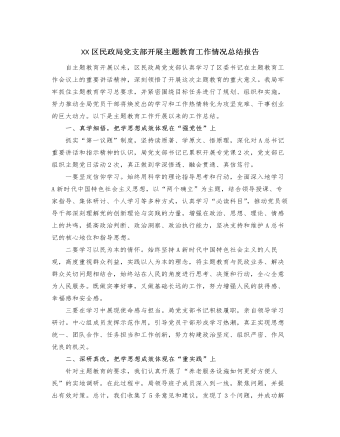
XX区民政局党支部开展主题教育工作情况总结报告
二要专注于解决问题。根据市委促进经济转型的总要求,聚焦“四个经济”和“双中心”的建设,深入了解基层科技工作、学术交流、组织建设等方面的实际情况,全面了解群众的真实需求,解决相关问题,并针对科技工作中存在的问题,采取实际措施,推动问题的实际解决。三要专注于急难愁盼问题。优化“民声热线”,推动解决一系列基层民生问题,努力将“民声热线”打造成主题教育的关键工具和展示平台。目前,“民声热线”已回应了群众的8个政策问题,并成功解决其中7个问题,真正使人民群众感受到了实质性的变化和效果。接下来,我局将继续深入学习主题教育的精神,借鉴其他单位的优秀经验和方法,以更高的要求、更严格的纪律、更实际的措施和更好的成果,不断深化主题教育的实施,展现新的风貌和活力。
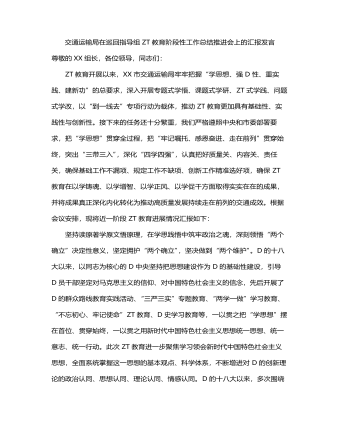
交通运输局在巡回指导组主题教育阶段性工作总结推进会上的汇报发言
今年3月,市政府出台《关于加快打造更具特色的“水运XX”的意见》,提出到2025年,“苏南运河全线达到准二级,实现2000吨级舶全天候畅行”。作为“水运XX”建设首战,谏壁闸一线闸扩容工程开工在即,但项目开工前还有许多实际问题亟需解决。结合“到一线去”专项行动,我们深入到谏壁闸一线,详细了解工程前期进展,实地察看谏壁闸周边环境和舶通航情况,不断完善施工设计方案。牢牢把握高质量发展这个首要任务,在学思践悟中开创建功之业,坚定扛起“走在前、挑大梁、多做贡献”的交通责任,奋力推动交通运输高质量发展持续走在前列。以学促干建新功,关键在推动高质量发展持续走在前列。新时代中国特色社会主义思想着重强调立足新发展阶段、贯彻新发展理念、构建新发展格局,推动高质量发展,提出了新发展阶段我国经济高质量发展要坚持的主线、重大战略目标、工作总基调和方法论等,深刻体现了这一思想的重要实践价值。
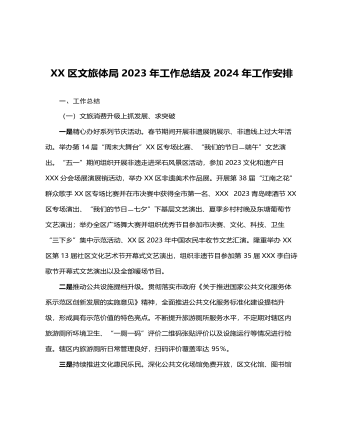
XX区文旅体局2023年工作总结 及2024年工作安排
三、2024年工作计划一是完善基层公共文化服务管理标准化模式,持续在公共文化服务精准化上探索创新,围绕群众需求,不断调整公共文化服务内容和形式,提升群众满意度。推进乡镇(街道)“114861”工程和农村文化“121616”工程,加大已开展活动的上传力度,确保年度目标任务按时保质保量完成。服务“双减”政策,持续做好校外培训机构审批工作,结合我区工作实际和文旅资源优势,进一步丰富我市义务教育阶段学生“双减”后的课外文化生活,推动“双减”政策走深走实。二是结合文旅产业融合发展示范区,全力推进全域旅游示范区创建,严格按照《国家全域旅游示范区验收标准》要求,极推动旅游产品全域布局、旅游要素全域配置、旅游设施全域优化、旅游产业全域覆盖。
今日更新Word
-

精选高中生期末评语
1、该生学习态度端正 ,能够积极配合老师 ,善于调动课堂气氛。 能够积极完成老师布置的任务。学习劲头足,听课又专注 ,做事更认 真 ,你是同学们学习的榜样。但是,成绩只代表昨天,并不能说明你 明天就一定也很优秀。所以,每个人都应该把成绩当作自己腾飞的起 点。2、 你不爱说话 ,但勤奋好学,诚实可爱;你做事踏实、认真、为 人忠厚 ,是一个品行端正、有上进心、有良好的道德修养的好学生。在学习上,积极、主动,能按时完成老师布置的作业,经过努力 ,各 科成绩都有明显进步,你有较强的思维能力和学习领悟力,学习也有 计划性,但在老师看来,你的潜力还没有完全发挥出来,学习上还要有持久的恒心和顽强的毅力。
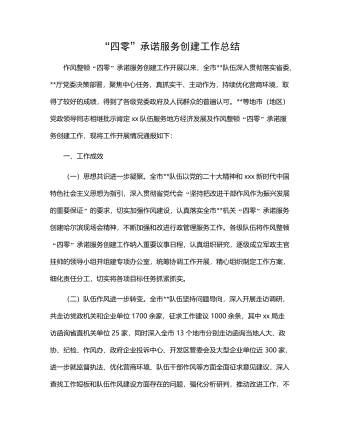
“四零”承诺服务创建工作总结
(二)坚持问题导向,持续改进工作。要继续在提高工作效率和服务质量上下功夫,积极学习借鉴其他部门及xx关于“四零”承诺服务创建工作的先进经验,同时主动查找并着力解决困扰企业和群众办事创业的难点问题。要进一步探索创新,继续优化工作流程,精简审批程序,缩短办事路径,压缩办理时限,深化政务公开,努力为企业当好“保姆”,为群众提供便利,不断适应新时代人民群众对政务服务的新需求。(三)深化内外宣传,树立良好形象。要深入挖掘并及时总结作风整顿“四零”承诺服务创建工作中形成的典型经验做法,进一步强化内部宣传与工作交流,推动全市创建工作质效整体提升。要面向社会和公众庄严承诺并积极践诺,主动接受监督,同时要依托电台、电视台、报纸及微信、微博等各类媒体大力宣传xx队伍作风整顿“四零”承诺服务创建工作成果,不断扩大社会知情面和群众知晓率。
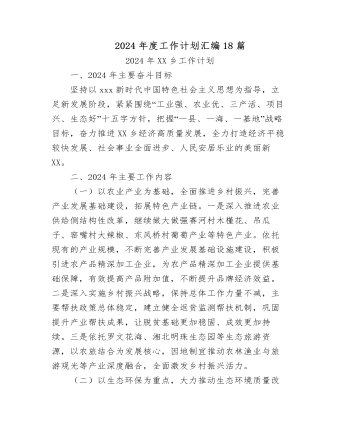
2024年度工作计划汇编(18篇)
1.市政基础设施项目5项,总建设里程2.13km,投资概算2.28亿元。其中,烔炀大道(涉铁)工程施工单位已进场,项目部基本建成,正在办理临时用地、用电及用水等相关工作;中铁佰和佰乐(巢湖)二期10KV外线工程已签订施工合同;黄麓镇健康路、纬四路新建工程均已完成清单初稿编制,亟需黄麓镇完成图审工作和健康路新建工程的前期证件办理;公安学院配套道路项目在黄麓镇完成围墙建设后即可进场施工。2.公益性建设项目6项,总建筑面积15.62万㎡,投资概算10.41亿元。其中,居巢区职业教育中心新建工程、巢湖市世纪新都小学扩建工程已完成施工、监理招标挂网,2月上旬完成全部招标工作;合肥职业技术学院大维修三期已完成招标工作,近期签订施工合同后组织进场施工;半汤疗养院净化和医用气体工程已完成招标工作;半汤疗养院智能化工程因投诉暂时中止;巢湖市中医院(中西医结合医院)新建工程正在按照既定计划推进,预计4月中下旬挂网招标。

驻村工作队2024年第一季度工作总结汇编(4篇)
三是做大做强海产品自主品牌。工作队于xx年指导成立的冬松村海产品合作社,通过与消费帮扶平台合作,在工作队各派出单位、社会团体、个人支持下,已获得逾xx万元销售额。2022年底工作队推动合作社海产品加工点扩建的工作方案已获批,待资金下拨后将正式启动扩建工作。四是积极助企纾困,带动群众增收致富。工作队利用去年建立的xx镇产业发展工作群,收集本地企业在产品销售、技术、人力、资金、运营、用地等方面的需求,并加大xx支持乡村振兴力度,xx助理赴各村委开展多场xx政策支持乡村振兴宣讲活动,本季度有x万元助农贷款获批,xx万贷款正在审批中。在壮大既有产业的同时,完善联农带农机制,一方面鼓励企业雇用本地农户就业,另一方面计划与本地农户签订长期收购合同,让农民种得放心、种得安心,带动当地群众共同致富。

主题教育总结常用提纲大全
第一,主题教育是一次思想作风的深刻洗礼,初心传统进一步得到回归。第二,主题教育是一次沉疴积弊的集中清扫,突出问题进一步得到整治。第三,主题教育是一次强化为民服务的生动实践,赤子之情进一步得到提振。第四,主题教育是一次激发创业担当的有利契机,发展层次进一步得到提升。2.第一,必须提领思想、武装思想。第二,必须聚焦问题、由表及里。第三,必须领导带头、以上率下。第四,必须务实求实、认真较真。3.一是抬高政治站位,坚持大事大抓。二是坚持思想领先,狠抓学习教育。三是突出问题导向,深入整改纠治。四是坚持领导带头,发挥表率作用。4.一是立足“早”字抓筹划。二是着眼“活”字抓学习。三是围绕“统”字抓协调。5.一是形势所需。二是任务所系。三是职责所在。四是制度所定。6.一要提升认识。二要积极作为。三要密切协作。
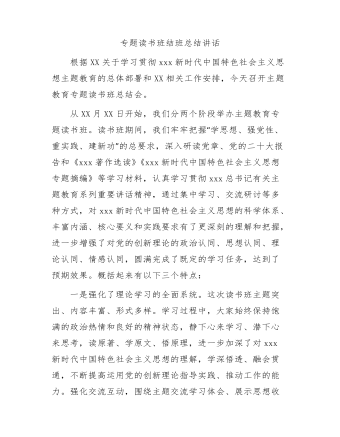
主题教育专题读书班结班总结讲话
第二,要把调查研究贯穿始终,实干担当促进发展。开展好“察实情、出实招”“破难题、促发展”“办实事、解民忧”专项行动,以强化理论学习指导发展实践,以深化调查研究推动解决发展难题。领导班子成员要每人牵头XX个课题开展调查研究,XX月底前召开调研成果交流会,集思广益研究对策措施。各部门、各单位要制定调研计划,通过座谈访谈、问卷调查、统计分析等方式开展调查研究,解决工作实际问题,帮助基层单位和客户解决实际困难。第三,要把检视问题贯穿始终,廉洁奉公树立新风。认真落实公司主题教育整改整治工作方案要求,坚持边学习、边对照、边检视、边整改,对标对表xxx新时代中国特色社会主义思想,深入查摆不足,系统梳理调查研究发现的问题、推动发展遇到的问题、群众反映强烈的问题,结合巡视巡察、审计和内外部监督检查发现的问题,形成问题清单。

















